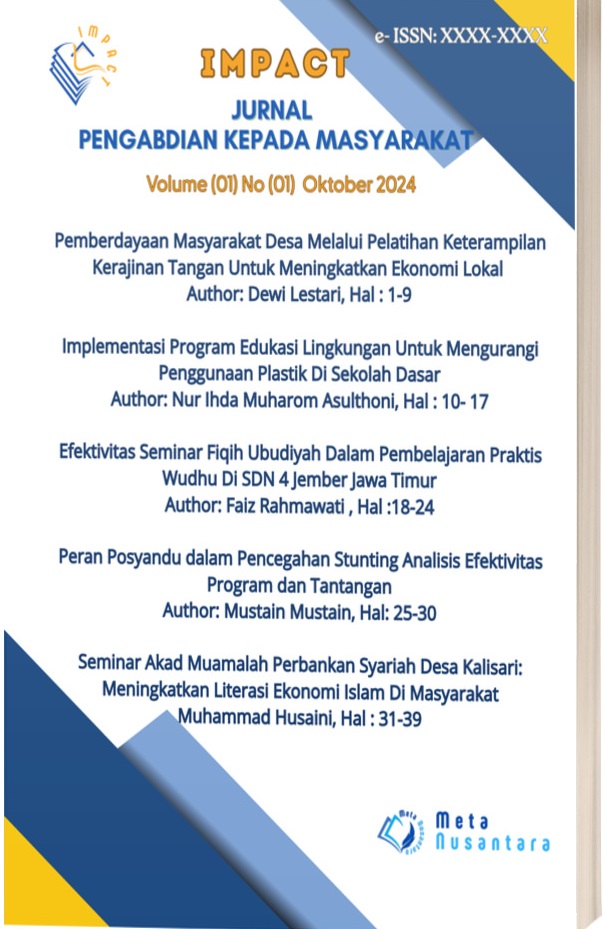Pemberdayaan Masyarakat Desa Melalui Pelatihan Keterampilan Kerajinan Tangan Untuk Meningkatkan Ekonomi Lokal
DOI:
https://doi.org/10.010425/28ed1n09Keywords:
Community Empowerment, Handicraft Skills, Local EconomyAbstract
Empowering rural communities through handicraft skills training has become one of the effective strategies in improving the local economy. In the midst of economic challenges faced by rural communities, skills development based on local potential can provide sustainable business opportunities. This research uses a qualitative approach with the Participatory Action Research (PAR) method, which involves the community as an active subject in the research. The main data sources were obtained through in-depth interviews, participatory observations, and focus group discussions (FGDs) with trainees, instructors, and policy makers in Mlowokarangtalun Village Pulokulon Grobogan.The purpose of this study was to analyse the impact of handicraft skills training on improving the economy of the village community and identify supporting and inhibiting factors in the implementation of this empowerment programme. The results showed that skills training based on inorganic waste utilisation was able to increase participants' income from an average of Rp1,000,000 to Rp2,500,000 per month. In addition, there are significant social changes, such as increased independence, self-confidence, and active participation in the community. These results are in line with the concept of empowerment, which emphasises the active participation of the community in the process of local economic development
Downloads
References
Adi, I. R. (2008). Intervensi Komunitas: Pengembangan Masyarakat sebagai Upaya Pemberdayaan Masyarakat. Jakarta: Rajawali Pers.
Aziz, A., et al. (2005). Pemberdayaan Masyarakat melalui Pelatihan Kerajinan Tangan di Desa Y. Jurnal Pemberdayaan Komunitas, 3(1), 12-25.
Chambers, R. (1995). Pembangunan yang Berpusat pada Rakyat: Pendekatan Partisipatif. Jakarta: LP3ES.
Fahrudin, A. (2012). Pemberdayaan Masyarakat: Model dan Strategi. Bandung: Humaniora.
Hidayat, S., et al. (2018). Pelatihan Pembuatan Keset dari Limbah Kain untuk Meningkatkan Pendapatan Perempuan di Desa X. Jurnal Pengabdian Masyarakat, 5(2), 45-56.
Haryono, Eko, Moch Ridwan Al Murtaqi, et al. 2024. “Metode-Metode Pelaksanaan PkM (Pengabdian Kepada Masyarakat) Untuk Perguruan Tinggi.” Al Fattah Ejournal Sma Al Muhammad Cepu 5(02): 1–21.
Haryono, Eko, Siti Suprihatiningsih, et al. 2024. “New Paradigm Metode Penelitian Kepustakaan (Library Research) Di Perguruan Tinggi.” An-Nuur 14(1).
Haryono Eko Rangkuti Rizki Kurniawan, Sariman, Suprihatiningsih Siti. 2024. “Metodologi Penelitian Kualitatif Dan Kuantitatif .” https://www.rcipress.rcipublisher.org/index.php/rcipress/catalog/book/949 1: 248.
Ife, J., & Tesoriero, F. (2016). Community Development: Alternatif Pengembangan Masyarakat di Era Globalisasi. Yogyakarta: Pustaka Pelajar.
Mardikanto, T., & Soebiato, P. (2015). Pemberdayaan Masyarakat dalam Perspektif Kebijakan Publik. Jakarta: Salemba Humanika.
Mikkelsen, B. (2011). Metode Penelitian Partisipatoris dan Upaya Pemberdayaan: Panduan untuk Praktisi Lapangan. Jakarta: Yayasan Obor Indonesia.
Suharto, E. (2009). Membangun Masyarakat Memberdayakan Rakyat: Kajian Strategis Pembangunan Kesejahteraan Sosial dan Pekerjaan Sosial. Bandung: Refika Aditama.
Sumodiningrat, G. (1997). Pemberdayaan Masyarakat dan Jaring Pengaman Sosial. Jakarta: Gramedia Pustaka Utama.
Sariman, Sariman, Eko Haryono, Muhammad Wahyudin, and Faiz Zainal Muttaqin. 2024. “Exploring Research Methodologies Qualitative In Higher Education: Strategies And Approaches For Academic Inquiry.” Al Fattah Ejournal Sma Al Muhammad Cepu 4(01): 74–103. https://www.ejournal.smaamc.sch.id/index.php/belajar/article/view/43.
Downloads
Published
Issue
Section
License
Copyright (c) 2024 Dewi Lestari (Author)

This work is licensed under a Creative Commons Attribution 4.0 International License.




